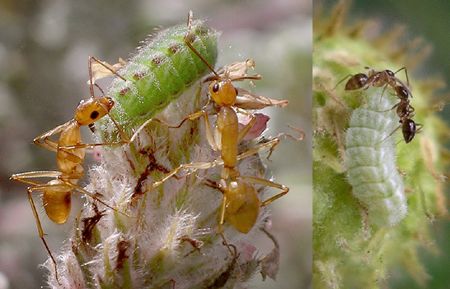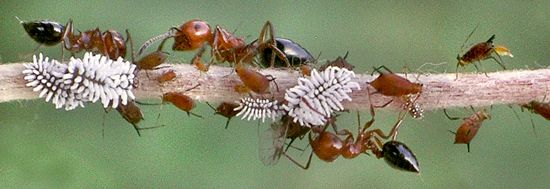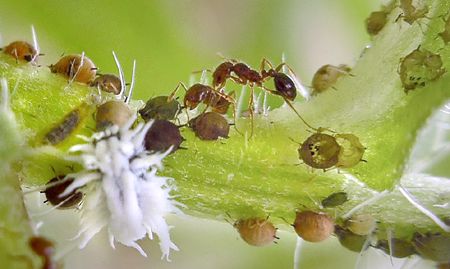 Ant & Aphids |  Ants & Mealybugs |
Everyone likes to have friends. Associations with other individuals can be pleasant, useful, and sometimes crucial to one's wellbeing. Building relationships is a major factor in the lives of many mammals, including ourselves. And it gets really interesting when the pairing reaches beyond the species boundaries. Innumerable stories about people and dogs illustrate interactions that range from the heartwarming to the amazing, as do accounts of birds and mammals, fish and birds, and even predators and prey.
But what about invertebrates? Considering that insects have little in the way of brainpower, it is obvious that movies such as "Antz" and "A Bug's Life" take a bit of artistic license when it comes to portraying relationships. Well, and the fact that those insects can talk and do a lot of things that most people find challenging. As engaging as the characters appear, they are, remember, just animated fictional creations.
 Ant & Aphids |  Ants & Mealybugs |
Real life insects, however, do sometimes have rather remarkable associations, and one taxon stands out as a major player in these situations: ants. There are relatively few highly social insects compared to the multitudes of solitary species. Eusociality is the rule for termites, but it is most widespread in the hymenoptera, especially honey bees and the family Formicidae.
Ants are some of the best defended insects. They live in colonies where they enjoy the advantages bestowed by sheer numbers. The female workers and soldiers communicate with each other, have sharp jaws that they readily use against prey and adversaries, and many have stingers (an ovipositor modified to deliver venom, such as formic acid or alkaloids). Anybody who has been stung by the Imported Fire Ant, Solenopsis invicta, knows the effectiveness of such stings.
 Ants & Butterfly Caterpillars |
A similar relationship with ants occurs among some butterfly caterpillars. Like aphids, the larvae of hairstreaks and blues in the family Lycaenidae, are very slow moving and tend to just sit on their plants while feeding. They, too, ingest more liquid than they need and so generate the sweet waste product that lures ants. It's interesting to note that the ant species attracted to the herbivores range from very tiny to rather large, and there is no guarantee that any particular caterpillar or aphid colony will even have attendants. The association occurs often enough, though, that the advantages have favored its evolution.
 Ants, Aphids & Lady Beetle Larvae |
So what happens if no ants are guarding aphids or if their attentions are inadequate to protect their defenseless little charges? Plenty. There is a reason that aphids have evolved rapid reproduction, which, by sheer multiplication, can usually counter the ravages of predators and parasitoids and ensure the species' survival.
As the ant/aphid relationship developed, so did the aphids' predators' arsenal of ways to deal with the ants. Many kinds of lady beetles specialize in eating aphids. This is why they are a popular biological control among gardeners. Lady beetles are predators both as adults and as larvae. In fact, the immature beetles probably eat more aphids as they grow and develop than the adults who must also spend time mating and laying eggs. Lady beetle larvae usually just crawl up to an aphid and eat it. An ant might object to that, though, and drive the beetle away. Some lady beetle larvae have a counterstrategy and produce waxy coverings that chemically hide them from the ants. The secretions the beetles produce not only look a lot like those of mealybugs but evidently also fool the ants, as they ignore these interlopers that are feasting on their aphids. The aphids, in turn, seem to have no clue that their neighbors are being gruesomely devoured and they are probably next. The "wolf in sheep's clothing" seems an apt metaphor here.
 Ants, Aphids (Alive & Parasitized), Lady Beetle Larva & Flower Fly Maggot |
In our sophisticated anthropomorphic imaginations we can easily project how horrible all this carnage is, sympathizing with the victims and their not-always-so-effective protectors, but in the entomological realm, it is more like business as usual. Remember, they are just bugs.